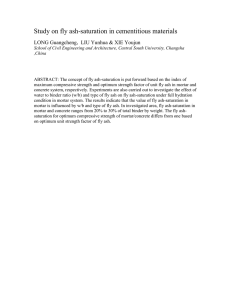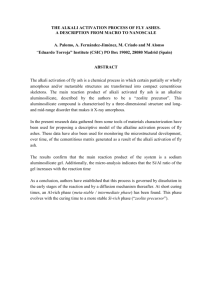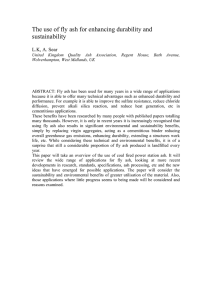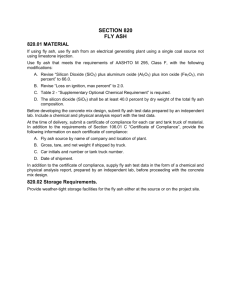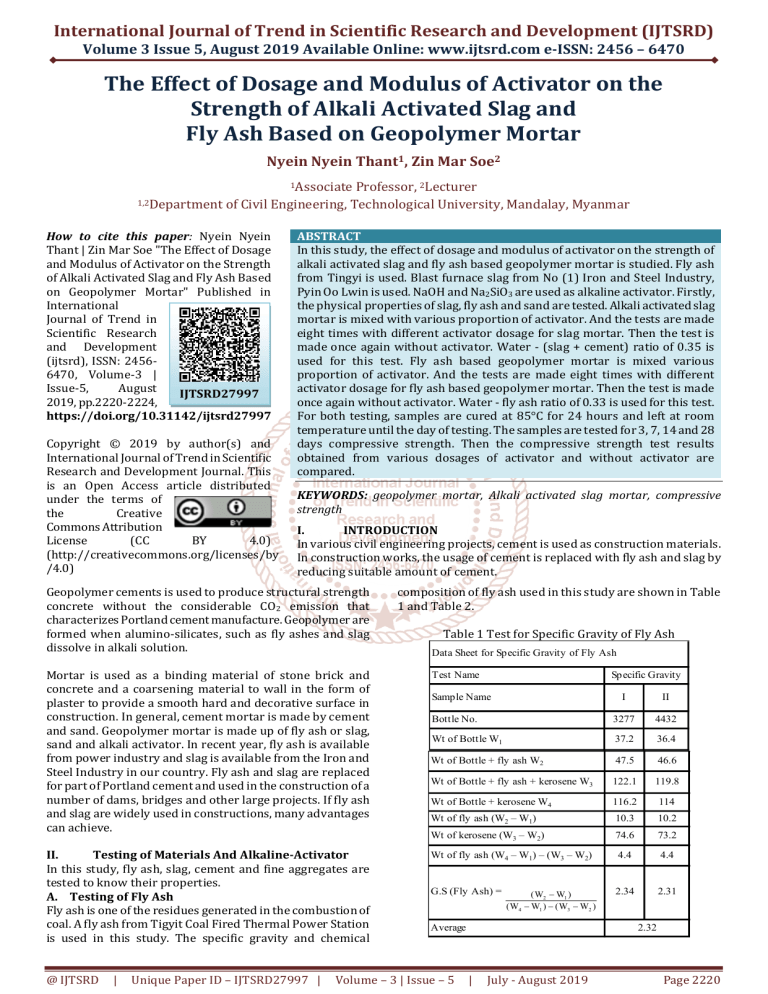
International Journal of Trend in Scientific Research and Development (IJTSRD)
Volume 3 Issue 5, August 2019 Available Online: www.ijtsrd.com e-ISSN: 2456 – 6470
The Effect of Dosage and Modulus of Activator on the
Strength of Alkali Activated Slag and
Fly Ash Based on Geopolymer Mortar
Nyein Nyein Thant1, Zin Mar Soe2
1Associate
Professor, 2Lecturer
1,2Department of Civil Engineering, Technological University, Mandalay, Myanmar
How to cite this paper: Nyein Nyein
Thant | Zin Mar Soe "The Effect of Dosage
and Modulus of Activator on the Strength
of Alkali Activated Slag and Fly Ash Based
on Geopolymer Mortar" Published in
International
Journal of Trend in
Scientific Research
and Development
(ijtsrd), ISSN: 24566470, Volume-3 |
Issue-5,
August
IJTSRD27997
2019, pp.2220-2224,
https://doi.org/10.31142/ijtsrd27997
Copyright © 2019 by author(s) and
International Journal of Trend in Scientific
Research and Development Journal. This
is an Open Access article distributed
under the terms of
the
Creative
Commons Attribution
License
(CC
BY
4.0)
(http://creativecommons.org/licenses/by
/4.0)
ABSTRACT
In this study, the effect of dosage and modulus of activator on the strength of
alkali activated slag and fly ash based geopolymer mortar is studied. Fly ash
from Tingyi is used. Blast furnace slag from No (1) Iron and Steel Industry,
Pyin Oo Lwin is used. NaOH and Na2SiO3 are used as alkaline activator. Firstly,
the physical properties of slag, fly ash and sand are tested. Alkali activated slag
mortar is mixed with various proportion of activator. And the tests are made
eight times with different activator dosage for slag mortar. Then the test is
made once again without activator. Water - (slag + cement) ratio of 0.35 is
used for this test. Fly ash based geopolymer mortar is mixed various
proportion of activator. And the tests are made eight times with different
activator dosage for fly ash based geopolymer mortar. Then the test is made
once again without activator. Water - fly ash ratio of 0.33 is used for this test.
For both testing, samples are cured at 85°C for 24 hours and left at room
temperature until the day of testing. The samples are tested for 3, 7, 14 and 28
days compressive strength. Then the compressive strength test results
obtained from various dosages of activator and without activator are
compared.
KEYWORDS: geopolymer mortar, Alkali activated slag mortar, compressive
strength
I.
INTRODUCTION
In various civil engineering projects, cement is used as construction materials.
In construction works, the usage of cement is replaced with fly ash and slag by
reducing suitable amount of cement.
Geopolymer cements is used to produce structural strength
concrete without the considerable CO2 emission that
characterizes Portland cement manufacture. Geopolymer are
formed when alumino-silicates, such as fly ashes and slag
dissolve in alkali solution.
Mortar is used as a binding material of stone brick and
concrete and a coarsening material to wall in the form of
plaster to provide a smooth hard and decorative surface in
construction. In general, cement mortar is made by cement
and sand. Geopolymer mortar is made up of fly ash or slag,
sand and alkali activator. In recent year, fly ash is available
from power industry and slag is available from the Iron and
Steel Industry in our country. Fly ash and slag are replaced
for part of Portland cement and used in the construction of a
number of dams, bridges and other large projects. If fly ash
and slag are widely used in constructions, many advantages
can achieve.
II.
Testing of Materials And Alkaline-Activator
In this study, fly ash, slag, cement and fine aggregates are
tested to know their properties.
A. Testing of Fly Ash
Fly ash is one of the residues generated in the combustion of
coal. A fly ash from Tigyit Coal Fired Thermal Power Station
is used in this study. The specific gravity and chemical
@ IJTSRD
|
Unique Paper ID – IJTSRD27997 |
composition of fly ash used in this study are shown in Table
1 and Table 2.
Table 1 Test for Specific Gravity of Fly Ash
Data Sheet for Specific Gravity of Fly Ash
Test Name
Specific Gravity
Sample Name
I
II
Bottle No.
3277
4432
Wt of Bottle W1
37.2
36.4
Wt of Bottle + fly ash W2
47.5
46.6
Wt of Bottle + fly ash + kerosene W3
122.1
119.8
Wt of Bottle + kerosene W4
116.2
114
Wt of fly ash (W2 – W1)
10.3
10.2
Wt of kerosene (W3 – W2)
74.6
73.2
Wt of fly ash (W4 – W1) – (W3 – W2)
4.4
4.4
G.S (Fly Ash) =
2.34
2.31
(W2 W1 )
(W4 W1 ) (W3 W2 )
Average
Volume – 3 | Issue – 5
2.32
|
July - August 2019
Page 2220
International Journal of Trend in Scientific Research and Development (IJTSRD) @ www.ijtsrd.com eISSN: 2456-6470
Table 2 Normal Range of Chemical Composition for Fly
Ash
Chemical Component
Table 5 Summary of Test Results of Slag
Slag
Sample Name
Contained (%)
Fineness (cm /g)
1285
Silica (SiO­2 )
45.62
Consistency (%)
17.50%
Alumina (AL2 O3 )
10.84
Ferric Oxide (Fe2 O3 )
4.42
Calcium Oxide (CaO)
30.25
Magnesium Oxide (MgO)
1.43
Sulphur Trioxide (SO3 )
2.47
Loss on Ignition (LOI)
4.35
Table 3 Summary of Test Results of Fly Ash
Fly Ash
2
Fineness (cm /g)
2488
Consistency (%)
29%
Specific Gravity
2.32
3.87
Specific Gravity
The summary of test results of fly ash is shown in Table 3.
This table includes many tests. These tests are fineness test,
consistency test, specific gravity test, setting time test.
Sample Name
2
Setting Time(hr:min)
Initial Set
0:15
Without activator
Final Set
0:50
Setting Time(hr:min)
Initial Set
0:25
With NaOH
Final Set
0:45
Setting Time(hr:min)
Initial Set
0:15
With NaOH+Na2 SiO3
Final Set
0:25
Setting Time(hr:min)
Initial Set
0:05
With Na2 SiO3
Final Set
0:20
C. Chemical Compositions of Cement
Cement is a binding material and forms a paste when
contacts with water, which holds the fine aggregate together
to form solid mass. In this study, slag mortar combined with
AAA cement. Slag cannot be used only because it does not
fuse and bind with sand. The chemical compositions of AAA
cement are shown in Table 6.
Setting Time(hr:min)
Initial Set
0:10
Table 6 Chemical Compositions of AAA Cement
Composition in percent
Chemical Constituent
(%)
Silica (SiO2 )
19.42
Without activator
Final Set
2:00
Alumina (Al2 O3 )
4.4
Setting Time(hr:min)
Initial Set
0:15
Ferric Oxide (Fe2 O3 )
3.47
With NaOH
Final Set
2:10
Calcium Oxide (CaO)
62.34
Setting Time(hr:min)
Initial Set
0:15
Manganese Oxide (MgO)
3.17
With NaOH+Na 2 SiO3
Final Set
2:00
Sulphur Trioxide (SO3 )
2.12
Setting Time(hr:min)
Initial Set
0:20
Loss
2.92
With Na2 SiO3
Final Set
2:30
Total
97.84
B. Testing of Slag
In this research, blast furnace slag from No (1) Iron and Steel
Industry, Pyin Oo Lwin is used. Chemical compositions of
blast furnace slag are used in this study as shown in Table 4.
Table 4 Normal Range of Chemical Composition for Slag
Chemical Constituent
Composition in
percent (%)
Silica (SiO2 )
23.42
Alumina (Al2 O3 )
5.74
Ferric Oxide (Fe2 O3 )
7.65
Calcium Oxide (CaO)
25.76
Manganese Oxide (MnO)
D. Testing of Fine Aggregates (Sand)
The fine aggregate proposed to be used for making mortar
cubes and concrete cubes is river sand. River sand is used in
this study. The test results of fine aggregates are shown in
the following Tables.
Table 7 Test Results of Fineness Modulus of Sand
Test name Sieve analysis for fine aggregate
Description
Ayeyarwaddy River Sand
of sample
Percentage Retained
Sieve Size
Average
Percent
Retained
Cumulativ
e Percent
Specified
Limits %
Retained
19.2
4
–
–
0~5
Sulphur (S)
0.28
8
2
2
5~15
Carbon (C)
1.06
16
5.4
7.4
10~25
Mangnese (Mn)
0.928
30
27.68
25.08
10~30
50
57.18
92.26
15~35
100
6.42
98.68
12~20
200
0.4
–
2~4
Pan
0.92
–
1~3
F.M
–
2.35
2.2~2.8
The summary of test results of slag is shown in Table 5. This
table includes many tests. These tests are fineness test,
consistency test, specific gravity test, setting time test.
@ IJTSRD
|
Unique Paper ID – IJTSRD27997 |
Volume – 3 | Issue – 5
|
July - August 2019
Page 2221
International Journal of Trend in Scientific Research and Development (IJTSRD) @ www.ijtsrd.com eISSN: 2456-6470
Table 8 Test Results of Specific Gravity of Sand
Bottle no.
1
2
Wt. of bottle (W 1 ) (g)
149.6
153.7
Wt. of bottle + soil (W 2 ) (g)
696.8
660.5
Wt. of bottle + soil + water (W 3 ) (g)
1011.8
997.6
Wt. of bottle of water only (W 4 ) (g)
673.3
684.3
Wt. of soil used (W 2 ­ W 1 ) (g)
547.2
506.8
Wt. of water used (W 3 ­ W 2)
315
337.1
Wt. of soil (W 4 ­ W 1 ) ­ (W 3 ­ W 2 ) (ml)
208.7
193.5
2.62
2.62
Specific gravity of soil, Gs =
W2 ­ W1
(W4 ­ W1 ) ­ (W3 ­ W2 )
Table 9 Test Results of Absorption of Sand
Container no.
6.
7.
8.
9.
Water glass content of 5% by weight of slag
Water glass and NaOH content of 2.67% by weight of
slag
Water glass and NaOH content of 5% by weight of slag
Without activator in mortar
The summary of compressive strength test results of slag
mixed with various alkali activator contents are shown in
Table 10 the value of compressive strengths is illustrated in
Figure 1.
Table10. Compressive Strength Test Results of Alkali
Activated Slag Mortar Mixed with Various Alkali Activator
Contents
Activator
Compressive strength (psi)
3 days
7 days 14 days 28 days
NaOH 0.67% of slag weight
603.07 683.48
816.46
927.79
NaOH 1.3% of slag weight
402.04 556.68
649.46
819.55
NaOH 5% of slag weight
321.64 389.67
463.89
525.75
519.56
633.99
2
Wt. of container + wet sand (g)
137
143.2
Na2SiO3 0.67% of slag weight
340.19 422.15
Wt. of container + dry sand (g)
136
142.3
Na2SiO3 1.3% of slag weight
371.12 510.29
556.68
711.31
Wt. of container (g)
33.2
31.3
Na2SiO3 5% of slag weight
535.03 572.14
717.49
835.01
1
0.9
(NaOH +Na2SiO 3) 2.67% of slag
479.36 525.75
weight
587.6
612.34
102.8
111
(NaOH +Na2SiO 3) 5% of slag
weight
386.58
460.8
494.82
556.68
Without activator
296.89 309.26
448.43
504.08
Wt. of water (W w ) (g)
Wt. of dry sand (W d ) (g)
W
Absorption =
W
Average (%)
w
100
0.97
6
1
0.81
d
0.89
E. Alkaline-Activator
The most used alkaline activators are a mixture of sodium or
potassium hydroxide (NaOH, KOH) and sodium silicate or
potassium silicate. Mostly sodium hydroxide and sodium
silicates (Na2O=12% and SiO2 =30 are used in mortar. Since
potassium is more expensive than sodium, only sodium is
used in this study.
III.
Testing of Alkali Activated Slag Mortar
In this study, mixture is prepared to study the effect of
activator on the compressive strength of alkali activated slag
mortar. The mixture consists of slag, sand, alkali activator
and water. The slag is used 250g, cement is used 50g and
sand is used 600g for one sample. The variable dosages of
alkali activator are used such as 2g (0.67%), 4g (1.3%), 8g
(2.67%) and 15g (5%) of slag weight. The weight of water
for one sample is 105 ml.
In
this
test,
sand/(slag+cement)
of
2
and
water/(slag+cement) of 0.35 are used. All the samples are
put in the oven without delay time for curing at elevated
temperature of 85°C for 24 hours. After curing at elevated
temperature, the samples are cured at room temperature
until the day of testing. The variable dosages of activator
used in alkali activated slag mortar are:
1. NaOH content of 0.67% by weight of slag
2. NaOH content of 1.3% by weight of slag
3. NaOH content of 5% by weight of slag
4. Water glass content of 0.67% by weight of slag
5. Water glass content of 1.3% by weight of slag
@ IJTSRD
|
Unique Paper ID – IJTSRD27997 |
Figure 1 Effect of Dosage of Activator on the Compressive
Strength of Alkali Activated Slag Mortar
The compressive strength of alkali activated slag mortar
without activator is the lowest and compressive strength of
alkali activated slag mortar with NaOH dosage of 0.67% is
the highest. In comparison of 3 days strength for NaOH, the
strength of NaOH 0.67% of slag weight is the highest and it is
also found that the strength of NaOH 0.67% is also the
highest in 7 days, 14 days and 28 days strength. When the
dosage of NaOH is increased 0.67%, 1.3% and 5%, the
strength is decreased in all specified days. In comparison of 3
days strength for Na2SiO3, the strength of Na2SiO3 5% of slag
weight is the highest and it is also found that the strength of
Na2SiO3 5% of slag weight is also the highest in 7 days, 14
days and 28 days strength. When the dosage of Na2SiO3 is
increased 0.67%, 1.3% and 5%, the strength is increased in
all specified days. In comparison of 3 days strength for
(NaOH+Na2SiO3), the strength of (NaOH+Na2SiO3) 2.67% of
slag weight is the highest and it is also found that the
strength of (NaOH+Na2SiO3) 2.67% is also the highest in 7
Volume – 3 | Issue – 5
|
July - August 2019
Page 2222
International Journal of Trend in Scientific Research and Development (IJTSRD) @ www.ijtsrd.com eISSN: 2456-6470
days, 14 days and 28 days strength. The strength of alkali
activated slag mortar with (NaOH+Na2SiO3) 2.67% of slag
weight is more than that of (NaOH+Na2SiO3) 5%. The
strength of alkali activated slag mortar with activator is
more than that without activator. So, the strength of slag
mortar with NaOH is increased more than that of water
glass.
IV.
Testing of Fly Ash Based Geopolymer Mortar
In this study, mixture is prepared to study the effect of
activator on the compressive strength of geopolymer mortar.
The mixture consists of fly ash, sand, alkali activator and
water. The fly ash is used 300g and sand is used 600g for one
sample. The variable dosages of alkali activator are used
such as 2g (0.67%), 4g (1.3%), 8g (2.67%) and 15g (5%) of
fly ash weight. The weight of water for one sample is 100 ml.
In this test, sand/fly ash of 2 and water/fly ash of 0.33 are
used. All the samples are put in the oven without delay time
for curing at elevated temperature of 85°C for 24 hours.
After curing at elevated temperature, the samples are cured
at room temperature until the day of testing.
The variable dosages of alkali activator used in fly ash based
geopolymer mortars are:
1. NaOH content of 0.67% by weight of fly ash
2. NaOH content of 1.3% by weight of fly ash
3. NaOH content of 5% by weight of fly ash
4. Water glass content of 0.67% by weight of fly ash
5. Water glass content of 1.3% by weight of fly ash
6. Water glass content of 5% by weight of fly ash
7. Water glass and NaOH content of 2.67% by weight of fly
ash
8. Water glass and NaOH content of 5% by weight of fly ash
9. Without activator in mortar
The summary of compressive strength test results of fly ash
mixed with various alkali activator contents are shown in
Table 11. The values of compressive strength are illustrated
in Figure 1.
Table11. Compressive Test Results of Fly Ash Based
Geopolymer Mixed with Various Alkali Activator Contents
Activator
NaOH 0.67% of fly
weight
NaOH 1.3% of fly
weight
NaOH 5% of fly ash
weight
Na2SiO 3 0.67% of fly
ash weight
Na2SiO 3 1.3% of fly ash
weight
Na2SiO 3 5 % of fly ash
weight
Compressive strength (psi)
3 days 7 days 14 days
28 days
556.67 649.46
865.94
1066.96
432.97 572.14
711.31
927.79
556.68
649.96
717.49
293.8
989.65 1020.6 1051.45 1113.35
742.23 865.94
927.79
1005.11
550.49 695.85
927.79
989.64
(NaOH+Na2SiO 3) 2.67%
1175.21 1237.1 1267.98
of fly ash weight
(NaOH+Na2SiO 3) 5% of
402.04 508.82 732.97
fly ash weight
Without activator
@ IJTSRD
|
1298.91
989.65
896.86 927.79 1020.57 1113.35
Unique Paper ID – IJTSRD27997 |
Figure2. Effect of Dosage of Activator on the Compressive
Strength of Fly Ash Based Geopolymer Mortar
From this test result, the compressive strength of fly ash
based geopolymer mortar with (NaOH+Na2SiO3) dosage of
2.67% is the highest and with NaOH dosage of 5% is the
lowest from those test result. In comparison of 3 days
strength for NaOH, the strength of NaOH 0.67% of fly ash
weight is the highest and it is also found that the strength of
NaOH 0.67% of fly ash weight is also the highest in 7 days, 14
days and 28 days strength. When the dosage of NaOH is
increased 0.67%, 1.3% and 5%, the strength is decreased in
all specified days. In comparison of 3 days strength for
Na2SiO3, the strength of Na2SiO3 0.67% of fly ash weight is
the highest and it is also found that the strength of Na2SiO3
0.67% of fly ash weight is also the highest in 7 days, 14 days
and 28 days strength. When the dosage of Na2SiO3 is
increased 0.67%, 1.3% and 5%, the strength is decreased in
all specified days.
In comparison of 3 days strength for (NaOH+Na2SiO3), the
strength of (NaOH+Na2SiO3) 2.67% of fly ash weight is the
highest and it is also found that the strength of
(NaOH+Na2SiO3) 2.67% is also the highest in 7 days, 14 days
and 28 days strength. When the dosage of Na2SiO3 is
increased 2.67% and 5%, the strength is decreased in all
specified days. The fly ash based geopolymer mortar with
activator 2.67% of (NaOH+Na2SiO3) is more than that
without activator. But the compressive strengths of that
mortar with 5% of NaOH, NaOH+Na2SiO3, Na2SiO3, 0.67% of
NaOH and 1.3% of NaOH, Na2SiO3 are less than that of
without activator. The fly ash based Geopolymer mortar,
Na2SiO3 5% of fly ash weight is equal to (NaOH+ Na2SiO3) 5%
of fly ash weight and Na2SiO3 0.67% of fly ash weight is equal
to without activator in 28 days. So, there is no effect of
activator on the strength of fly ash based geopolymer
mortar.
V.
Conclusion
In this study, materials used for mortar are fly ash, slag,
alkali activator and sand. Firstly, physical property tests such
as fineness test, setting time test, specific gravity test and
consistency test are performed for constituents’ materials.
Alkali activator of sodium hydroxide and water glass are
used. In this study, the proportion of mortar is 1:2. Water-fly
ash ratio is 0.33; water-(slag cement) ratio is 0.35 and
various activator dosages are used to test the compressive
strength after 3 days, 7 days, 14 days and 28 days.
Volume – 3 | Issue – 5
|
July - August 2019
Page 2223
International Journal of Trend in Scientific Research and Development (IJTSRD) @ www.ijtsrd.com eISSN: 2456-6470
In slag mortar, slag cannot be used only because it does not
fuse and bind. So, slag has to be mixed with small amount of
cement in this study. In slag mortar, the higher dosage of
NaOH is used, the lower the compressive strength is
obtained and the higher dosage of water glass is used, the
more increase the compressive strength of mortar is
obtained. In fly ash mortar, the higher dosage of activator is
used, the lower the compressive strength of mortar is
obtained.
The 28 days compressive strength of slag mortar is the
highest when the mortar is mixed with NaOH 0.67% of slag
weight in all proportions. It is found that the strength of
alkali-activated slag mortar is influenced by NaOH. Activator
dosage is effectively influenced on the strength of alkali
activated slag mortar. The 28 day compressive strength of fly
ash based geopolymer mortar is the highest when the
mortar is mixed with 2.67% of (water glass+ NaOH) of fly
ash weight in all proportions. It is found that the
compressive strength of the fly ash based mortar with and
without activator is not much different. So, there is no effect
of activator on the strength of fly ash based geopolymer
mortar.
REFERENCES
[1] A. Fernández-Jiménez1 A. Palomo2, D. Revuelta3;
Alkali Activation of Industrial By-products to Develop
New Earth-riendly Cements:1,2,3Eduardo Torroja
Institute for Construction Science, (CSIC) Madrid,
Spain, 6-9 September 2009, Bath, UK.
@ IJTSRD
|
Unique Paper ID – IJTSRD27997 |
[2] Anja Buchwald,Weimar:What are Gopolymer? Current
state of research and technology, the opportunities
they offer, and their significance for the precast
industry,BFT 07/2006
[3] Mark Drechsler, Adelaide, Geopolymers: A New
Technology for sustainabilityin Mining, Construction
and Hazardous Waste Industries: South Australia, +61
(8) 8405 4300, PB Network #62 February 2006
[4] Louise M.Keyte, Grant C. Lukey and Jannie S.J.van
Deventer."The effect of cool ash composition on the
properties of waste-based geopolymers. Depertment of
chemical and Biomolecular Engineering, The University
of Melbourne, Victoria, Australia, ISRS-2004"
[5] Pennsylvania Avenue: Coal Ash; Edison Electric
Institute 1701, N.W. Washington, D.C. 20004-2696
[6] S.E. Wallah; B.V. Rangan: Low-calcium fly ash based
geopolymer Concrete; Long-term properties. Research
report GCI. http://www.geopolymer.org/library/
[7] Josephl. Lawson: on the Determination of the Elastic
properties of Geopolymeric Materials: procedding of
Master of Science in Mechanical Engineering from the
Rochester Institute of Technology Rochester NY.
[8] B. K Paul & R. P Pama, International Ferro cement
Information Centre (1978).
Volume – 3 | Issue – 5
|
July - August 2019
Page 2224

